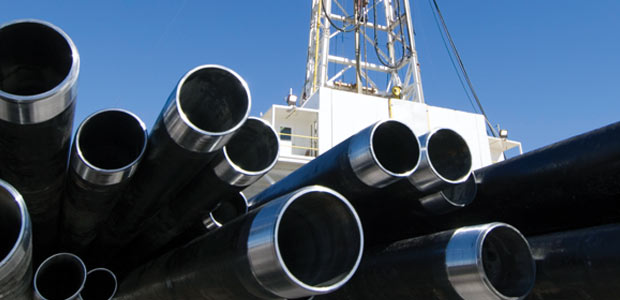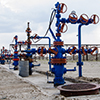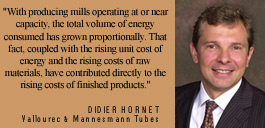
Litany Of Market Factors Conspire To Drive Tightness In OCTG Supply & Demand
By Al Pickett Special Correspondent
Chart-topping rig counts and an insatiable global appetite for steel–especially in China, India and developing nations around the globe–are creating the perfect storm for balancing oil country tubulars supply with increased demand, according to the oil and gas companies that consume OCTG as well as the mills that provide tubular products to the upstream industry.
While elevated oil and gas prices provide producers and operators with the revenue streams to continue aggressive rilling and field development programs, those same price decks translate to incremental cost pressures for the companies responsible for manufacturing pipe in a market characterized by near-record prices for raw steel. OCTG consumers and suppliers agree there is more to the tight supply and demand situation than meets the eye.
The domestic industry drilled more than 53,500 wells last year and cut 343 million feet of bore hole, the most since 1984. That means all types of OCTG–from drill pipe, to casing, to production tubulars, to line pipe–are in top demand. Increased demand, of course, generally correlates to increased prices, and the situation is only exacerbated by international steel costs that have risen dramatically in recent years.
“Tubular goods are in tight supply with no relief in the foreseeable future,” assesses Ollis Anderson, the material manager for Continental Resources Inc. in Enid, Ok.
Like many other independents, Continental Resources is active in unconventional resource plays (namely the Bakken oil shale in the Williston Basin and the Woodford gas shale in the Arkoma Basin), which require dense well spacings with high well counts, meaning much more steel has to be run into the ground than in conventional reservoir development. “If you are short on tubulars, your drilling program is going to be stopped in its tracks, so procuring sufficient tubular products to meet our needs in these plays is a concern,” Anderson says.
OCTG Shortage
Robert Martin, who oversees all OCTG management for Kaiser-Francis Oil Company in Tulsa, agrees. “There is a shortage of virtually all OCTG stock,” he says. “I do not know of any vendors with stock on the ground of any size, weight or grade that is actually for sale. Most all the majors and large independents have entered into stocking programs with OCTG primary stocking distributors, which have tied up all the existing inventories of OCTG as well as the majority of mill rollings coming this fall and winter at ‘unknown’ prices.”
Martin continues by explaining that unlike the past when purchasers and manufacturers agreed to a set price before milling new pipe, pricing points are not being established today until a pipe order is ready to ship. “Most all mills and distributors are selling pipe coming off future mill rollings at a ‘price in effect at time of shipment,’” he remarks. “This means the end user is promised pipe with an estimated delivery at a price that will not be known until the pipe is actually shipped.”
Robert Okrzesik, director of seamless sales for Evraz Rocky Mountain Steel, acknowledges the tight OCTG supply to meet the needs of operators’ ever-increasing drilling programs. “Operators have had to become more creative in securing the volumes of OCTG to support their aggressive drilling programs,” Okrzesik says. “For the most part, however, I think operators have been able to meet their drilling needs. The high-strength alloy casing product range is in tight supply, so operators will continue to be challenged to procure those needs.”
In some cases, however, operators are having to consider OCTG availability as they plan their drilling activities, contends Didier Hornet, managing director of the North American OCTG division for Vallourec & Mannesmann Tubes. “In particular, tubulars for land-based drilling and completion are in high demand,” Hornet reports. “The effects of this higher demand are compounded by the fact that operators in given areas are using similar designs for drilling and completing their wells, which is creating preferentially strong demand for particular types and sizes of tubular products.”
Demand For Steel Products
Aside from increased demand from an industry running just shy of 2,000 rigs in late August, the most obvious factor impacting the OCTG market is steel cost and availability, according to Joe Alvarado, president of U. S. Steel Tubular Products, North America’s largest manufacturer of tubular products.
“We have seen a significant increase in demand for steel products, from the oil and gas industry as well as other industries,” Alvarado states. “Supplies have been tight in the first half of 2008. Part of that is because of an inventory rundown in the second half of 2007.”
Despite increased demand for drilling pipe, casing and tubing, Alvarado says OCTG supply has managed to keep pace. According to Preston Pipe & Tube Report, North American distributors and end users had 2.28 million tons of steel pipe inventories in May 2008. That was 11,000 tons more than May 2007 and only 18,000 tons below the record high reached in July 2007. “So total supply has kept up with demand, even though there may be tightness for certain OCTG products,” Alvarado contends.
But what about producers who point out lead times for OCTG products are being extended and scheduled manufacturing dates and deliveries are being delayed? “Inventories have dropped 96,000 tons, or 4.0 percent, since the beginning of the year. But inventories do not reflect a problem with supply,” Alvarado maintains. “Demand is strong, but we try to be as flexible as possible. We have certain products, such as large outside-diameter casing, that are rolled only once or twice a quarter. So lead times are inherently longer on those products compared with products that are rolled every month.”
Kaiser-Francis’ Martin says the problem of lead time is not limited to oil country tubular goods only. “Lead times on almost all oil field equipment have been extended,” he notes. “Steel tanks have doubled in cost in the last year, and take four to six weeks for delivery. Production equipment costs have increased 40-50 percent, depending on the type of equipment and how much alloy steel it takes to fabricate it, and lead times are as long as 16 weeks. Wellheads have increased about the same.
“Lead times on OCTG depend on the item, whether your company has restrictions on particular mills, and the quantity you want,” Martin goes on. “Mill rollings are out four to six months on OCTG, with some mills and distributors requiring an upfront 30 percent deposit on rolling items. Many items from China are delayed because of government-ordered shutdowns of mills because of air quality standards and the Beijing summer Olympics.”
Hornet points out that V&M Tubes is primarily organized for cyclic production and delivery. “We produce on scheduled rolling cycles and are not specifically generating a backlog that is defined in terms of lead times,” he relates. “Outside the United States, the situation is a bit different since we sell directly to oil companies who carry their own inventories. Our backlog is around seven months for the OCTG business outside North America.”
Scott Barnes, vice president and chief commercial officer for TMK IPSCO, says comparing lead times and backlogs to the past is not valid for the company, since TMK IPSCO is now operating under new ownership.
“We are ramping up some idle and new U.S. capacity as we are amending our business model,” states Barnes. “TMK IPSCO has experienced some delays in steel deliveries, which has caused changes in our production schedules. We are fortunate to have several product lines that help diversify market risk. But in the first half of the year, both our industrial and energy businesses were strong. The industrial business now appears to be slowing in the second half, and we are moving discretionary production capacity to supply more energy demand. Lead times are difficult because end users are changing their well designs frequently as they learn more about the new unconventional plays.”
Major Impact
Barnes says the surge in drilling activity has had a major impact on the OCTG market. “I do not believe anyone saw the run-up in drilling activity that has taken place this year,” he contends. “Industry analysts as recently as late last fall were projecting essentially flat growth in the United States and a drop in drilling activity in Canada. Oil and gas prices were falling, and there was concern about the amount of natural gas in storage if there was a warmer-than-normal winter. Several of the investment banking firms that conduct surveys of oil and gas company capital spending plans for 2008 were reporting activity levels similar to 2007.”
Hornet agrees that 2008 has taken everyone in the industry by surprise. “The consumption of OCTG was expected to be close to 2007 levels, but with domestic activity ramping up and more efficient rig operations, and some destocking at the end of 2007, consumption is higher than predicted,” he notes. “So far, the production is pretty well meeting the consumption, but there is no excess domestic capacity. Operators should have a good focus on their individual planning, without excess safety margin, to make sure they get what they need but do not artificially add tension to the supply/demand environment with overstocking.”
Barnes also points out that 2007 was a year of reducing tubular inventories, a trend that continued through the end of last year. “About last November we began to feel the effects of a weak U.S. currency and a run-up in commodity prices driven by growing demand in emerging markets,” he recalls. “Commodity price increases for oil, natural gas, iron ore, coking coal and scrap stimulated higher operating levels to supply these raw materials. Consequently, the demand for OCTG turned around very quickly in 2008.”
Seeking to react to higher oil and gas prices, operators scrambled to increase their 2008 drilling programs, according to Barnes. “Infrastructure has been trying to keep pace, but many of the new unconventional fields require higher-grade tubulars that have longer processing time for heat treating,” he continues. “These items include 41/2- and 51/2-inch API P110 OCTG. The supply chain has reacted, and many domestic OCTG suppliers, including TMK IPSCO, are altering product mixes, hiring additional shifts and expanding capacity wherever they can.”
As a case in point, Barnes notes that TMK IPSCO is ramping up new heat-treating production capacity at its ERW facility in Blytheville, Ar., and is expanding its operations in Baytown, Tx., including installing new heat-treating capacity.
Hornet estimates that domestic OCTG inventories industrywide are slightly more than four months, which is the lowest level in several years. “With the increased consumption rates of today’s more efficient rigs, this inventory level is critical,” he remarks. “Nevertheless, the inventory is high in tons and statistics may not fully encompass some end users’ inventory build to address drilling growth opportunities. Imported pipe comprises a considerable portion of the OCTG supply, particularly in the mid- and smaller-sized outside diameters and common grades. Exchange rates are a key factor in the import picture.”
Raw Material Costs
Just as American consumers have learned this summer that global demand impacts U.S. gasoline prices, the same is true for the cost of steel, according to Alvarado. “The cost of making steel has increased because all steel-making inputs have gone up substantially in the past year,” he emphasizes. “The cost increases are driven by a rise in global steel demand, and growth in developing countries is driving the pursuit of raw materials.”
Okrzesik agrees. “We think costs for basic raw materials such as iron ore, coke, alloys and scrap will continue to remain at high levels, and we expect world steel demand to continue to rise over the long term, keeping enough tension on supply to support these elevated cost levels,” he offers.
“Steel and raw material costs are driven by demand,” adds Hornet. “With the increasing industrialization of the Far East and Asia, demand is still growing. In the near term, raw material costs will not go down for sure, but it remains a challenge to predict the supply demand evolution of raw material.”
Rising energy input costs also impact the cost of pipe and OCTG products. Many of the mills are fired by natural gas, which remains at historically high prices. According to U. S. Steel’s annual report, the company will utilize 100,000 million Btu of natural gas in 2008. Alvarado also points out that the market prices for iron pellets are up 82 percent, pig iron is up 98 percent, scrap iron is up 69 percent, coal is up 200 percent, and coke is up 45 percent.
“With producing mills operating at or near capacity, the total volume of energy consumed has grown proportionally,” explains V&M Tubes’ Hornet. “That fact, coupled with the rising unit cost of energy and the rising costs of raw materials, has contributed directly to the rising costs of finished products. Energy impacts final costs in many ways. These include the costs to operate electrical steel-making facilities, gas and electrical heat-treating lines, basic plant operations, and transportation costs related to rail or truck.”
Tension On Input Costs
“The higher input costs such as natural gas, scrap, electricity, alloys and freight are huge pieces of overall cost and are the primary drivers for substantially higher OCTG prices in 2008,” Okrzesik adds. “Although some of these higher costs may begin to stabilize in the short term, in the longer term, we expect global demand to remain robust and continue to keep tension on input costs.”
Martin points out that while increased drilling activity has played a large role in the tight pipe supply, other elements have contributed to the situation, such as the increase in steel usage by China, India and Middle East nations.
“China’s thirst for structural steel and the shortage of iron ore have been major factors in the worldwide shortage of steel in general, not just OCTG,” Martin observes. “Mills have cut back distributors’ tonnage, which has created a very fragile market for both the distributor network and end users. Most major distributors have overbooked their allocated tonnage because the mills have come back to them and reduced the tonnage that they thought they were going to receive, and restricted the amount they can order of the tightest, most widely used items, such as 41/2- and 51/2-inch alloys, limiting the distributor network to only 30 percent of their total order on those particular items.”
Barnes underscores the fact that steel prices are set by the market forces of supply and demand. “Despite the negative talk about the economy in the press, the general market for steel has been steady,” he claims. “International steel prices to date in 2008 have been equal to or higher than North American markets. Factor in higher transportation costs and a weaker dollar, and the net return for foreign steel often is more attractive in markets outside of North America.
“Demand for steel products around the world has been good, which has supported higher steel prices,” Barnes goes on. “There is some debate whether steel prices will now plateau, continue to rise, or even fall back. Certainly, a manufacturer must cover costs, and steel pricing is a major cost driver for OCTG, but pipe prices also are determined by supply and demand. We believe that pipe companies will preserve an ability to pass on all cost increases to customers, although lag times can sometimes occur.”
Imported Steel
Okrzesik says demand levels continue to outpace supply, meaning OCTG inventories have not increased, but have decreased on a per rig basis in 2008 from last year’s levels. To help make up the difference, he points out that imported steel has increased to more than 50 percent of total supply today. “OCTG imports appear to be increasing significantly, and we think that means the supply tightness may ease somewhat in late 2008,” he explains. “But with an increasing rig count, we may not feel any relief at all.”
Okrzesik says imports can only go so far to meeting operators’ tubular needs. “While we expect OCTG imports to play a large part of the total supply, there are some dangers in import supply, such as quality and delivery integrity, that could leave operators without tubular supply,” he remarks. “Overall, for 2009, we think the general trend will be similar to 2008: tight supply at these higher price levels.”
“Imported pipe has helped a great deal with the shortage of OCTG, primarily with carbon steel tubes,” acknowledges Kaiser-Francis Oil Company’s Martin. “More U.S. end-users are taking a closer look at the third-world alloys, as they become available, their respective companies may not have considered before.”
Martin says his company knows from first-hand experience that the spot OCTG market is very tight. “Mills are cutting allocations to distributors, which causes the distributors to have to juggle pipe to end-users to cover orders. You can only stretch available pipe so far,” he says. “Most of the pipe that distributors do have in their stocks is presold and is on hold for stocking programs with major end-users. It will be very interesting to see what happens in the fourth quarter with all this pipe that has been booked, paid for, and promised by the mills to be delivered. There could be major problems filling stocking programs with promised pipe that is supposed to be coming in November and December.”
However, TMK IPSCO’s Barnes claims total OCTG inventories are in balance. “Some items appear to be in higher demand than others as drilling designs have shifted with more unconventional wells being drilled,” he acknowledges. “Depending on the analyst, estimates vary between four and five months of supply. Imports have been increasing and are now arriving at a pace close to 50 percent of the market. China, in particular, has been a major exporter of OCTG, while at the same time being a major consumer of other types of steel products.”
Mergers And Acquisitions
One thing that has changed the dynamics of the steel market is the acquisition of U.S. companies by foreign-owned manufacturers. For example, TMK, the largest pipe producer in Russia and one of largest in the world, announced in June that it had completed the acquisition of the U.S. assets of IPSCO Tubular’s business from a Swedish company, SSAB Svenkst Stal AB, under a back-to-back transaction with Evraz.
TMK acquired 100 percent of share capital in IPSCO Tubulars Inc. and 51 percent of share capital in NS Group Inc. for $1.25 billion. TMK and Evraz also have entered into a call/put option for the remaining 49 percent of NS Group, which may be exercised for $500 million.
TMK acquired 10 production sites in seven states with combined pipe production capacity of more than 1 million tons, including 300,000 tons of seamless pipe and in-house steel-making capacity of 450,000 tons of billets annually, according to the news release announcing the acquisition. In addition to pipe rolling and steel-making capacity, TMK’s acquired assets boast 450,000 tons of annual heat treatment capacity, 750,000 tons of threading capacity, and the capacity to manufacture up to 240,000 premium connection joints.
For its part, U. S. Steel expanded its presence in the U.S. tubulars market last year when it acquired Lone Star Technologies for $2.1 billion, according to Alvarado. He says his company also is engaged in new product development and productivity improvements.
“That is a continual process,” he says. “We continue to make capital investments where required, and hire additional manpower in our producing and finishing facilities to take advantage of limited available operating turns.”
Alvarado says U. S. Steel offers a full complement of API OCTG products, including its proprietary ultrahigh-strength grades USS 140 and V150, a family of enhanced collapse performance products for all standard API sizes, and a full range of sour service grades, including its proprietary C90, C95, C100 and C110 pipe.
Evraz also has been aggressive in adding more U.S. OCTG capacity with the acquisition of Oregon Steel Mills’ Rocky Mountain Steel seamless mill in 2007, according to Okrzesik, and in Canada with the acquisition of three former IPSCO OCTG facilities in Saskatchewan and Alberta.
“Although we continue to improve our OCTG manufacturing efficiency, we also are analyzing a variety of options to create more value for our OCTG customers,” Okrzesik relates. “Our OCTG facilities are running at full capacity.”
V&M Tubes also has made investments to expand and optimize manufacturing capacity, according to Hornet. “V&M Tubes has used capital expenditures to maximize the production efficiencies of our facilities both in the United States and internationally. While we have not added new rolling capacity, we are working to produce as much as possible from existing production facilities,” Hornet emphasizes. “We also have completed the acquisition of TCA, which will increase our capacity and enable us to optimize production routes. Internationally, we are in the initial stages of building a new, fully integrated steel and tube plant in Brazil. This new facility will be in partnership with Sumitomo.”
Unconventional Plays
One of the key drivers for OCTG consumption in the United States today is unconventional plays, especially shale gas formations such as the Barnett, Woodford, Fayetteville, Haynesville Shale and Marcellus. These plays not only require dense well spacing and/or horizontal well bores to drain the ultralow-permeability reservoirs, but they also tend to have extreme depletion curves that require operators to continually drill to offset production decline rates.
“Unconventional gas plays utilizing horizontal drilling techniques and multizone hydraulic fracture operations are creating huge demand in the 41/2- through 95/8-inch alloy casing size range,” responds Okrzesik. “Activity in these plays also is driving demand for premium connection technology, where high-collapse, tension and high-torque connections are required in the casing strings. There continues to be interest for even higher collapse OCTG grades. Evraz is focusing on developing higher collapse grades beyond P110 at our ERW OCTG facilities in Canada and our seamless OCTG facilities in the United States. That is what customers need in these multifrac, high-pressure, horizontal plays.”
V&M Tubes also is shipping lots of OCTG products to shale plays, according to Hornet. “At present, the need is more related to the availability of API-type grades and connections,” he says. “Sizes such as 51/2-inch N80 and 7-inch N80 and P110 are used in greater volumes in these plays. Moderate well depths, pad drilling and high rig efficiencies combine to put these types of products in high demand, and higher tonnages are required to meet the demand.”
Although Hornet says he believes pipe grades and sizes are available that are generally adequate for the longer-reach horizontals in shales and tight sands, he says greater loads for torque and bending are placed on the connections in the long laterals used in unconventional horizontal wells. “We offer both pipe and connections for long horizontal completions requiring high torque for rotating liners,” he says. “Our research and development groups also are continuing to work on new technologies for tubulars and connections for these demanding horizontal applications.”
Horizontal OCTG Designs
Continental Resources’ Anderson says carbon grades are typically used for surface and intermediate casing strings in horizontal shale wells, while high-strength, heavy-wall alloys are being used for production strings. “Most companies are using the same type of OCTG designs in horizontal shale plays, which means oil and gas companies are competing for the same type of pipe, ” he remarks. “Mills are allocating distribution as to how many tons and what size and type they are able to get each month.”
Anderson adds that larger-diameter, high-strength alloys such as P110 are being used in almost all horizontal shale plays because of the frac pressures. “Supplies of both 51/2- and 41/2-inch P110 are extremely tight,” he reports. “All sizes, grades and types of pipe–drill pipe, casing, tubing and line pipe–are in short supply. Everything is double to triple the price from one year ago. Heat treating and threading also are restricting supply.”
Alvarado agrees there is strong demand for 41/2- through 7-inch outside diameter casing and high-strength materials, such as API N80 through P110, in part because of deeper wells and more horizontal drilling.
Kaiser-Francis Oil Company’s Martin claims that 41/2-inch, 13.5-pound P-110; 51/2-inch, 20-pound and 23-pound P-110; and 7-inch, 26-pound and 29-pound P-110 are some of the hardest pipe to find with costs in the range of $3,200-$3,500 a ton. “All the shale gas projects have completely overwhelmed the 41/2-, 51/2- and 7.0-inch alloy markets,” he observes, “with companies involved looking to drill thousands or more of these types of wells in upcoming years.”
Dramatic improvements in rig efficiency (allowing each rig to drill more footage in less time) are a boon for operators and rig contractors alike, but actually are contributing to the supply/demand tightness for OCTG, Martin continues. “Improved rig efficiency is increasing the number of wells a rig can drill in a given year, with a corresponding increase in tubular requirements,” he emphasizes.
Barnes says he believes the trend toward developing unconventional resources will only gain more momentum going forward.
“Unconventional plays are only taking off, and oil and gas operators will push the envelope of technology to recover the hydrocarbons from these new plays,” he explains. “TMK IPSCO has a variety of premium connections, such as ultraflush joints and ultra-semiflush joints, which can meet the demands of horizontal drilling. We believe we could pool and leverage TMK IPSCO’s technical and R&D resources to work with operators to lend the engineering and support required to meet their needs through enhancing of existing products and developing new products. This year, TMK’s Russian plants are commissioning new rollings that will be producing high-class seamless tubulars suitable for all unconventional environments.”
Deepwater Challenges
Another example of providing new products to meet demand is pipe being used in the ultra-demanding Lower Tertiary trend in the ultradeepwater Gulf of Mexico, a potentially huge play where subsurface well depths extend to more than 20,000 feet and targets are below subsalt structures.
“We will work closely with the industry to provide the steel products to drill these challenging wells, including high-temperature/high-pressure product applications,” Alvarado promises.
Drilling, completing and producing deep wells in the Lower Tertiary trend is driving a new informal classification known as “extreme high-pressure/high-temperature,” according to Hornet.
“Operators and manufacturers of equipment and tubulars are working on 20,000 psi completions with extreme temperatures and the potential for sour environments,” he reflects. “This applies to risers as well as downhole tubulars. In conjunction with our tubular products and premium connections, we believe we have the technology to answer even the most critical of these applications. V&M continues to address industry needs with ultrahigh-collapse products as well as special grades for sour service such as 110 KSI mild sour service and C125. Although these fields are very promising, there are still problems to be solved, but we are confident the industry will meet the challenge.”
Forging New Relationships
To ensure operators have access to the OCTG products they need to complete their drilling programs, Alvarado says the industry must forge new working relationships. “It takes closer working relationships between the manufacturers, distributors and end-users to anticipate what is needed,” he emphasizes. “And we have to be sure our capital investments are in line with the exploration and production plans of our customers.”
Okrzesik says operators are learning to be creative to better procure the OCTG products they anticipate needing to complete their planned drilling programs. “We are already seeing operators planning beyond the traditional 90-180 days in procuring their OCTG needs,” he claims. “In some cases, we have seen operators building their own inventories to ensure supply. Some operators are utilizing alternate or modified string designs to match what is available in terms of size and grades. We likely will continue to see these and other innovative approaches to ensure OCTG supply.”
Planning is certainly the key for operators to be able to support their drilling programs, V&M Tubes’ Hornet emphasizes. “Depending on the specific grades and materials required, the planning horizon can vary significantly,” he says. “For example, smaller and midrange outside diameters and common grades with API connections would benefit from a three- to six-month forecast, while larger pipe sizes, high grades and premium connections are more like nine months for smooth deliveries. Very large outside diameters, such as 135/8-inch and larger pipe, and corrosion-resistant alloy grades can be in the range of one year or more. Working with manufacturers and distributors to develop systematic delivery schedules and avoid relying on the spot market can help operators avoid disruptions and delays in their drilling programs.”
Continental Resources’ Anderson agrees that planning is the key. “Operators are able to obtain sufficient drill pipe, casing and tubular supplies with adequate lead time, planning and forecasting,” he says. “If you do not have that, then you have a problem. And even with adequate planning, operators still may experience shortages because of delivery failures.”
Because of improved drilling efficiency and accelerated drilling activity in unconventional resource plays, Barnes says the time has come for operators to make changes in their planning models. He says he believes that is an issue that oil and gas companies should address as they plan their tubular programs for 2009.
“We have found that operators have become more efficient in their drilling operations,” Barnes relates. “The time to drill a well has contracted dramatically with the use of enhanced bits, new rigs and pad drilling operations with assembly line-type completions. This new operating efficiency has not always been well communicated with the internal supply chain of the operator, or his alliance partners. We find, for example, that wells that took 21 days to drill in past years are now taking 10 days. Also, the success rate for a commercial well has risen to the point that almost every hole will set pipe.
“My suggestion is that the planning departments within oil and gas companies review and update their planning models,” Barnes continues. “We are planning for another strong year of demand and expect pricing/costs to track within the ranges of 2008. We believe there has been a shift to higher highs and higher lows.”
For other great articles about exploration, drilling, completions and production, subscribe to The American Oil & Gas Reporter and bookmark www.aogr.com.





















